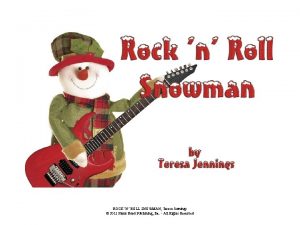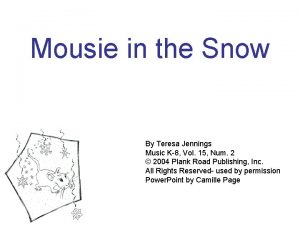NASAs Land Information System Supports Alaska Snow Analysis


- Slides: 2

NASA’s Land Information System Supports Alaska Snow Analysis for NOAA’s Operational Hydrologic Remote Sensing Center (NOHRSC) Christa D. Peters-Lidard, Sujay V. Kumar, Yuqiong Liu and the LIS Team, Code 617, NASA GSFC NOAA’s National Operational Hydrologic Remote Sensing Center (NOHRSC) recently implemented an experimental land surface model output for Alaska using NASA’s Land Information System (LIS) software. NOHRSC experimental LIS-based snowpack information for Alaska takes the form of a four-member "ensemble" consisting of two forcing data systems (GDAS and NAM) and two land surface models (CLM and Noah). Each forcing system is used to drive each model using NASA's Land Information System (LIS) software. Consequently, four independent sets of snowpack states are available: GDAS+CLM, GDAS+Noah, NAM+CLM, and NAM+Noah. Key: • NAM= the North American Mesoscale (NAM)model • GDAS= Global Data Assimilation System, • CLM= Community Land Model version 2. 0 • Noah= The Community Noah land surface model version 3. 2 Figure 1: The experimental modeled (NAM+Noah) snow water equivalent for May 23, 2012, 0: 00 Z. Figure 2: The experimental modeled (GDAS+CLM) snow water equivalent for May 23, 2012, 0: 00 Z. Differences from Figure 1 are related to differences in snowfall and snowpack physics.

Name: Christa D. Peters-Lidard and the LIS team, NASA/GSFC, Code 617 E-mail: Christa. Peters@nasa. gov Phone: 301 -614 -5811 References: Peters-Lidard , C. D. , P. R. Houser, Y. Tian, S. V. Kumar, J. Geiger, S. Olden, L. Lighty, B. Doty, P. Dirmeyer, J. Adams, K. Mitchell, E. F. Wood and J. Sheffield, 2007: High-performance Earth system modeling with NASA/GSFC's Land Information System. Innovations in Systems and Software Engineering. 3(3), 157 -165. DOI: 10. 1007/s 11334 -007 -0028 -x Kumar , S. V. , C. D. Peters-Lidard, Y. Tian, P. R. Houser, J. Geiger, S. Olden, L. Lighty, J. L. Eastman, B. Doty, P. Dirmeyer, J. Adams, K. Mitchell, E. F. Wood and J. Sheffield, 2006: Land Information System - An Interoperable Framework for High Resolution Land Surface Modeling. Environmental Modelling & Software, Vol. 21, 1402 -1415. DOI: 10. 1016/j. envsoft. 2005. 07. 004 Data Sources: LIS version 6 software, downloaded by agreement from lis. gsfc. nasa. gov by our partners at NOAA NOHRSC, including Gregory Fall on the NOHRSC team. Numerous other data sources used in the analysis, including NOAA’s Global Data Assimilation System (GDAS) and the North American Mesoscale (NAM) model products, available at http: //nomads. ncdc. noaa. gov/data. php. Technical Description of Figures: Figure 1: This figure is taken from the experimental NOHRSC page (http: //www. nohrsc. noaa. gov/interactive/html/map. htm), and shows the experimental modeled (NAM+Noah) snow water equivalent for May 23, 2012, 0: 00 Z. Figure 2: This figure is taken from the experimental NOHRSC page (http: //www. nohrsc. noaa. gov/interactive/html/map. htm), and shows the experimental modeled (GDAS+CLM) snow water equivalent for May 23, 2012, 0: 00 Z. Scientific significance: Improvements to land surface snowpack states, including snow water equivalent, snow depth, and snow cover, lead to direct improvements in streamflow and hydrological forecasting at NOAA River Forecast Centers supported by NOHRSC, such as the Alaska River Forecast Center. The flexibility and configurability of the LIS software infrastructure simplifies the process for improving snow and other hydrological analyses for our partners at NOAA/NOHRSC. Relevance for future science and relationship to Decadal Survey: The adoption of the LIS infrastructure by our partners at NOHRSC (under funding from NASA’s Earth Science Applications Program) sets them up to be early adopters of Decadal-Survey era data, including snowfall products from GPM, and freeze-thaw and/or soil moisture products from SMAP. The strongest interest is for snow-related products, which may be available from NPP/VIIIRS as well as ICESat-2, as well as eventually from the tier-3 SCLP mission.



